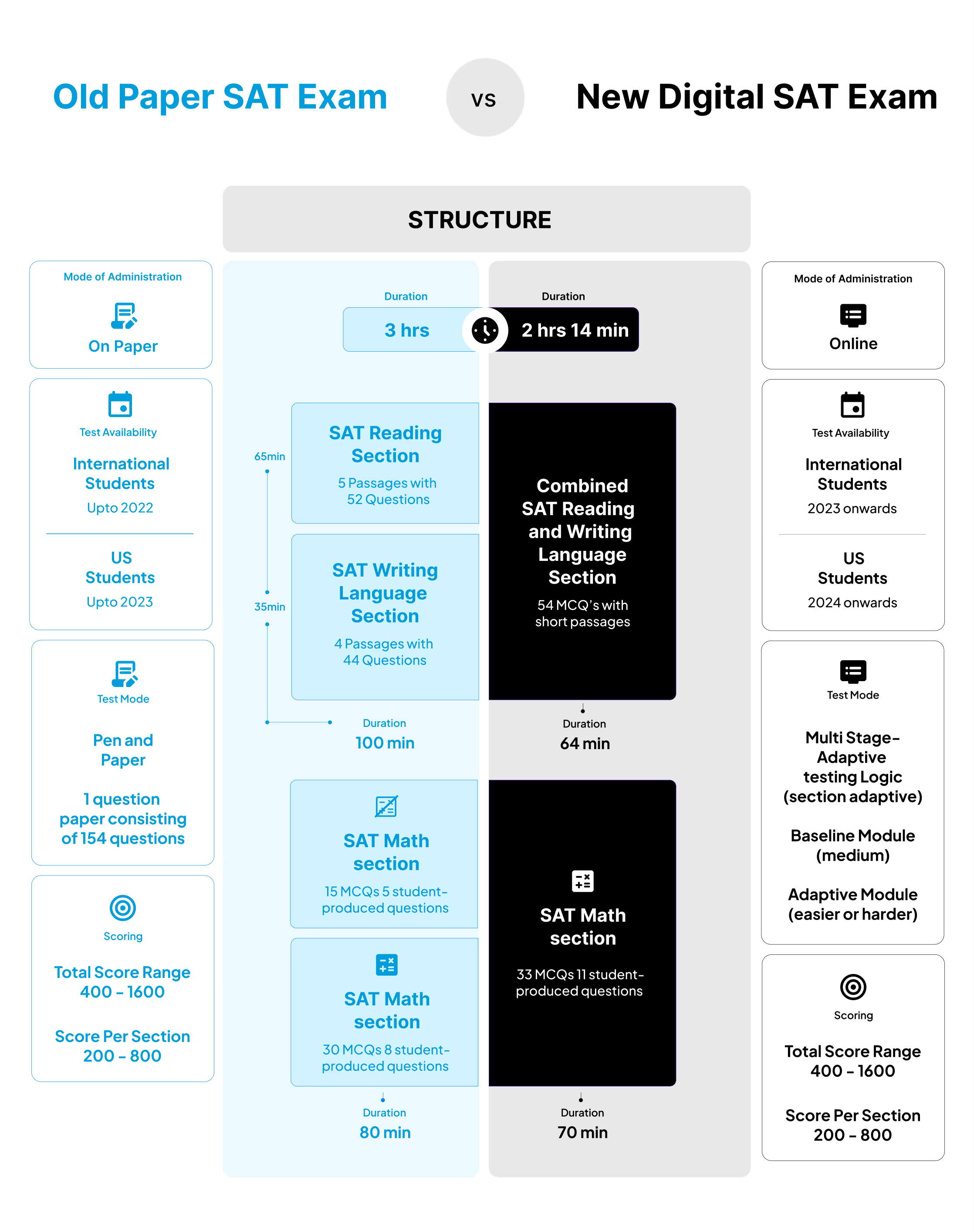

![How to Prepare for Digital SAT Exam [2025]](https://cdn.prod.website-files.com/62f0b227e38c6d799afcd8ba/675eae4d573999701dde2cad_6541424626e48f4a73f1efec_63c8cc57fa8217078f3a7e82_Digital_SAT_students_Teachers-p-500.avif)
![How to Prepare for Digital SAT Exam [2025]](https://cdn.prod.website-files.com/62d6876535c5c7559909754c/67c036910fbf3721b5778e27_Attendance_Zoom-min%201.png)

Key Takeaways
- Familiarize Yourself with the Format: The Digital SAT is adaptive, shorter, and combines Reading and Writing into one section.
- Leverage Official Resources: Use free practice tests from Khan Academy and the Bluebook app to prepare effectively.
- Adapt Study Strategies: Practice navigating the online interface and focus on question types specific to the new format.
Imagine a world where standardized testing adapts to your abilities, streamlines the process, and aligns with your learning experiences. Welcome to the era of the SAT digital testing! This comprehensive guide'll delve into everything you need to know about this groundbreaking shift in testing and how to prepare for success.
Preparing for the Digital SAT

Understanding how to prepare for the digital SAT is crucial for maximizing your score.
Students can maximize their score on the digital SAT by:
- Familiarizing themselves with the new format
- Underlining the significance of preparation
- Using the free practice tests provided by the College Board
- Following the checklist of necessary items for test day.
This section will cover official full length practice tests and resources, along with strategies for adapting study routines to the new format.
1. Official Practice Tests and Resources
The College Board offers official digital SAT practice tests through Khan Academy and the Bluebook app, with additional sample tests being made available periodically. Utilizing the official digital SAT prep provided by the College Board and Khan Academy is essential for effective preparation. Their partnership with the educational nonprofit Khan Academy provides online practice that accurately reflects the digital environment of the new SAT.
International students can access the new digital practice material on Khan Academy by confirming they will be taking the SAT after March 2023.
2. Adapting Study Strategies
For optimal test prep for the digital SAT, individuals are advised to:
- Answer all questions
- Familiarize themselves with the testing program features
- Practice specific topics and question types
- Utilize practice tests
- Take advantage of available resources
When preparing for the digital SAT, it is important to consider the differences between the digital test and paper test formats, practice using the online interface, and take advantage of available resources such as practice tests and study guides.
Experienced tutors can provide personalized instruction and guidance to help students prepare for the digital SAT. They can:
- Assess students’ strengths and weaknesses
- Create customized study plans
- Offer targeted practice materials
- Teach test-taking strategies specific to the digital format, such as navigating the online interface and managing time effectively
- Provide feedback and support to help students improve their performance and confidence in the digital SAT.
Scoring the Digital SAT
The digital SAT is scored on a 1600-point scale, with 800 points allocated to Math and 800 points allocated to Reading and Writing. Students will still receive comprehensive information from their SAT score reports, and the digital SAT Suite will provide data about local two-year colleges and workforce training programs correlated to their achievements, interests, and financial objectives.
This section will cover the adaptive stages and scoring, along with a comparison between paper and digital SAT scores.
1. Adaptive Stages and Scoring
Rights-based scoring involves weighting questions based on factors such as difficulty level and content area, ensuring that each question contributes proportionally to the overall score. The difficulty of a question on the digital SAT is impacted by factors such as question complexity, adaptive modifications based on preceding performance, and the complexity of the algorithm used to convert raw scores into scaled scores.
Early research on the College Board's practice tests indicates that questions of greater difficulty will have a higher value. However, students will not be informed of the exact number of questions they answered correctly or incorrectly on the new digital SAT.
2. Comparing Paper and Digital SAT Scores
Although the digital SAT will still be scored on a 1600 scale, superscoring between the current paper SAT and digital SAT will not be allowed. The correlation between ACT scores and SAT scores will remain unchanged, and the ACT/SAT Concordance will remain applicable, ensuring colleges can convert between SAT and ACT scores.
3. Test Day Tips for the Digital SAT
Selecting a test date well in advance is crucial for ensuring sufficient preparation time.
On test day, students must familiarize themselves with the rules and procedures for the digital SAT, along with understanding the elements that remain unchanged and those that have undergone alterations. This section will offer tips for test day, covering device preparation and requirements, and setting expectations for the test center.
4. Device Preparation and Requirements
Students should confirm that their device meets the specifications outlined by the College Board for the digital SAT. Acceptable devices include Windows laptops or tablets, Apple Mac laptops or iPads, or school-managed Chromebooks. Before test day, students must ensure their device is fully charged and that the Bluebook™ application is installed.
If students do not have their own device, they can request one from the College Board.
5. What to expect during the exam at the Test Center
Upon arriving at the test center on test day, students should ensure they are on time, comply with the test center rules and regulations, and be prepared for any possible technical issues. Students are expected to arrive no later than 7:45 a.m. for the SAT test, and acceptable photo identification is required for admission to the test center. Adhering to the test instructions and refraining from documenting or recording any information from the test is crucial to prevent having scores canceled.
Understanding SAT Digital Testing
As the world moves towards digital learning, the College Board is adapting the SAT to:
- Enhance security against cheating
- Improve accuracy in assessing students' abilities
- Eventually expand the number of locations and testing dates available
This transformation is driven by the College Board's vision for a more accessible and secure test, with a timeline for implementation in the US and internationally.
1. The College Board's Vision
The College Board seeks to increase accessibility, security, and alignment with students' learning experiences by transitioning to a digital format for the SAT. Modifications to the PSAT now reflect the same quantity of questions and time constraints as the SAT, while maintaining a difficulty level appropriate for the grade level. The transition to a digital SAT aims to streamline the process for students to submit test scores to colleges and universities. Furthermore, the new digital SAT Writing section will no longer include questions about idiomatic phrases or commonly-confused words, better aligning the test with the skills and knowledge students acquire in their high school class curriculum.
The College Board is steadfast in its commitment to accessibility, providing accommodations such as:
- braille and assistive technology compatible test formats for students with disabilities
- universal accessibility tools
- device lending to support students taking the digital SAT
2. Timeline for Implementation
The digital SAT will be released for international students in spring 2023, with US students following in 2024. The digital PSAT is slated to be available in October 2023.
After March 2024, taking the SAT on paper will no longer be feasible.
How Digital SAT Testing Works

The digital SAT enables computer-based adaptive testing. It takes approximately 2 hours and 14 minutes, roughly one hour less than the conventional paper and pencil version. Although the core content remains the same, noteworthy variations exist between the new digital SAT and its paper counterpart.
We will delve into the format and sections of the digital SAT, along with the necessary devices and applications for taking the test.
1. Test Format and Sections
The digital SAT consists of two sections with a break in between, comprising a Reading and Writing section and a Math section. Significant changes implemented for the digital SAT include:
- Adaptive testing
- Shorter passages
- More direct questions
- The combination of Reading and Writing sections
- The allowance of calculator use throughout the Math sections
- Calculator usage has been extended, with students accessing an integrated graphic calculator.
The SAT exam is getting an upgrade. It will be digital and take approximately two hours to complete.
2. Taking the Test: Devices and Applications
Students can take the digital SAT using either their own device or one provided by the College Board, utilizing a secure application known as Bluebook. To borrow a device, students can visit the College Board website for information regarding device lending.
If the internet disconnects while students take the digital SAT, they can continue the test with their progress saved. If the application or device crashes, students don't need to worry. Their progress will be saved, and they can resume the test.
How can you leverage EdisonOS for Digital SAT preparation & practice?
Students can leverage EdisonOS for Digital SAT preparation and practice in the following ways:
- Use our free full-length SAT practice test with adaptive modules to understand their test readiness and evaluate in detail the critical gaps in their skills and knowledge. Get their section-level analysis, difficulty analysis, which is crucial as tougher questions carry more weightage, time analysis on each section, and detailed answer explanations question-wise and tag-wise. Simulating real test conditions with these practice tests helps students build confidence and understand the pacing of the actual exam.
- Students can take advantage of Bluebook Insights. With Bluebook Insights, they can generate a detailed report from their existing Bluebook practice test reports, including insights into skill and knowledge gaps and performance across different difficulty levels.
Tutors can use EdisonOS for Digital SAT preparation and practice can significantly enhance both the effectiveness and efficiency of your SAT tutoring program. Here’s how:
- Comprehensive Test Management: EdisonOS allows you to create customized mock tests, which has never been easier. With EdisonOS, students can tailor their practice sessions to focus on specific areas of the SAT, ensuring targeted preparation and optimized learning outcomes or sectional tests and full-length adaptive tests.
- Advanced Analytics: You can provide detailed analytics on each student’s performance, including insights into skill and knowledge gaps, performance across different difficulty levels, and time management. This data-driven approach helps you tailor your teaching strategies to meet each student’s needs.
- Adaptive Learning: EdisonOS replicates the SAT testing environment precisely, giving students a realistic experience before the exam. From timing constraints to question formats, our platform ensures students feel confident and prepared on test day.
- Expert Crafted Extensive Question Banks: One of our standout features is our vast library of practice questions covering all subjects tested on the SAT, including the Reading and Writing section and Math. Tutors can explore various question types and topics, giving them ample opportunities for students to practice and strengthen their skills in every exam area.
The Future of Standardized Testing: SAT vs. ACT
While the SAT is shifting to a digital, adaptive, and more concise format, the ACT will remain unchanged for the foreseeable future. This raises an important question for students: Which test should they focus on? With the continuous evolution of the SAT and ACT, students need to stay informed and select the test that best aligns with their strengths and college goals.
Conclusion
The digital SAT represents a significant shift in standardized testing, aiming to improve accessibility, security, and alignment with students' learning experiences. As we've explored, it's crucial to understand the new format, adapt study strategies, and make the most of available resources to achieve a great score. Embrace the digital SAT and seize the opportunities it presents for your future academic success!
Frequently asked questions
The Digital SAT Test comprises two sections - Reading, Writing, and Math - each with 64 and 70 minutes of testing time, respectively, making it the perfect tool for measuring college and career readiness.
According to students and College Board experts, the digital SAT is generally easier than the paper-and-pencil version. This is due to its shorter duration, fewer questions, and computer-adaptive nature, which adjusts difficulty based on performance.
The digital SAT will be released for international students in spring 2023 and US students in 2024.
The digital SAT has undergone several major changes compared to the paper version, including adaptive testing, shorter passages, more direct questions, a combined Reading and Writing section, and the inclusion of calculators throughout the Math sections.
Students can take the digital SAT using Windows laptops or tablets, Apple Mac laptops or iPads, or school-managed Chromebooks with the Bluebook application.

Tutors Edge by EdisonOS
in our newsletter, curated to help tutors stay ahead!
Tutors Edge by EdisonOS
Get Exclusive test insights and updates in our newsletter, curated to help tutors stay ahead!












.png)
.webp)
